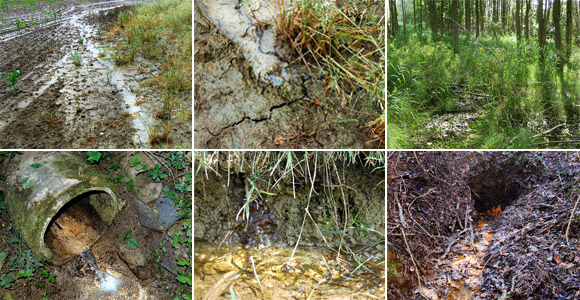The Rich Diversity of Water Flow Paths Makes the HOAL an Ideal Laboratory
A wide range of runoff generation mechanisms occurs in the HOAL which makes it a genuine laboratory where hypotheses of flow and transport can be tested, either by controlled experiments or by contrasting sub-regions of different characteristics. This diversity also ensures that the HOAL is representative of a range of catchments around the world.
Due to shallow, low permeable soils, the concave part of the catchment was tile drained in the 1950s in an effort to reduce water logging. Two tile drain systems do not dry out during the year while two are ephemeral.
There are two clearly visible springs that directly discharge into the stream draining the HOAL. The water from one of them originates from a fractured siltstone aquifer with distinct hydrologic and chemical characteristics while another spring has more shallow water contributions.
In the south-eastern part of the catchment is a small wetland close to the stream which permanently seeps into the stream. The wetland is fed by springs at its upper part and usually responds very quickly to all types of rainfall due to its high saturation state.
During high intensity thunderstorms in summer and spring, infiltration excess overland flow tends to occur with a very substantial, fast contribution from the tile drainage system.
During major storms, saturation overland flow occurs across the fields (mainly in the depression areas) which enters the stream at three locations. In winter rain-on-snow runoff may occur as saturation overland flow during large events which causes gully erosion.
The main runoff generation mechanism in winter is through lateral subsurface pathways (shallow subsurface preferential flowpaths, drainage pipes). Even minor events will lead to a significant increase of stream flow due to high soil moisture during the winter. After freezing periods, when the soil is still frozen, infiltration excess overland flow may occur.





